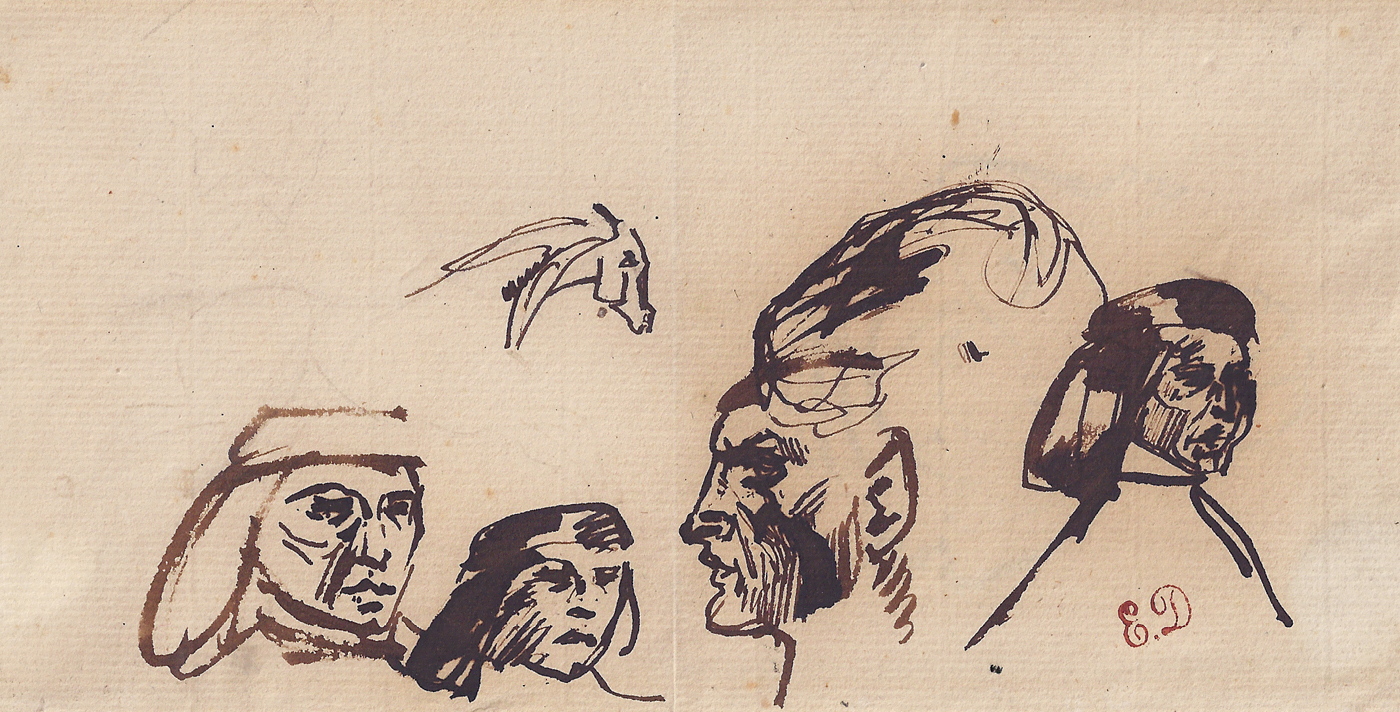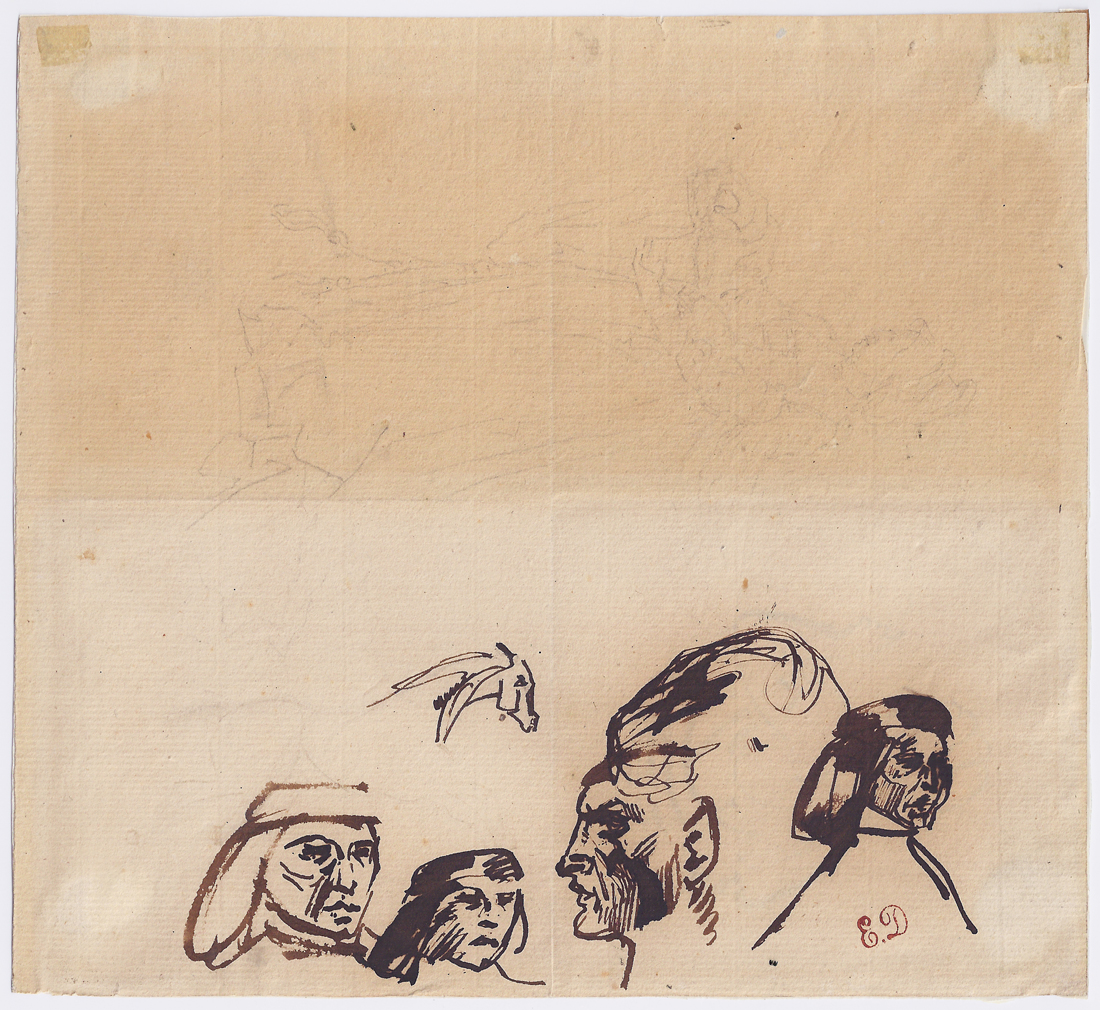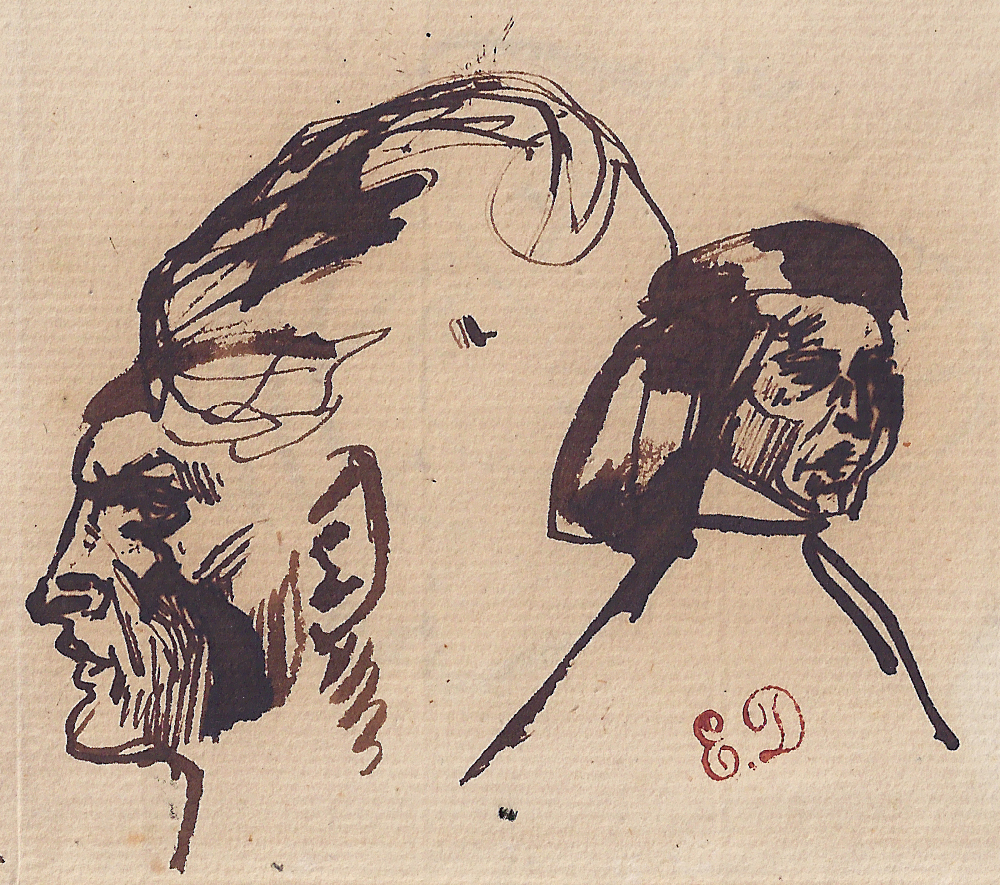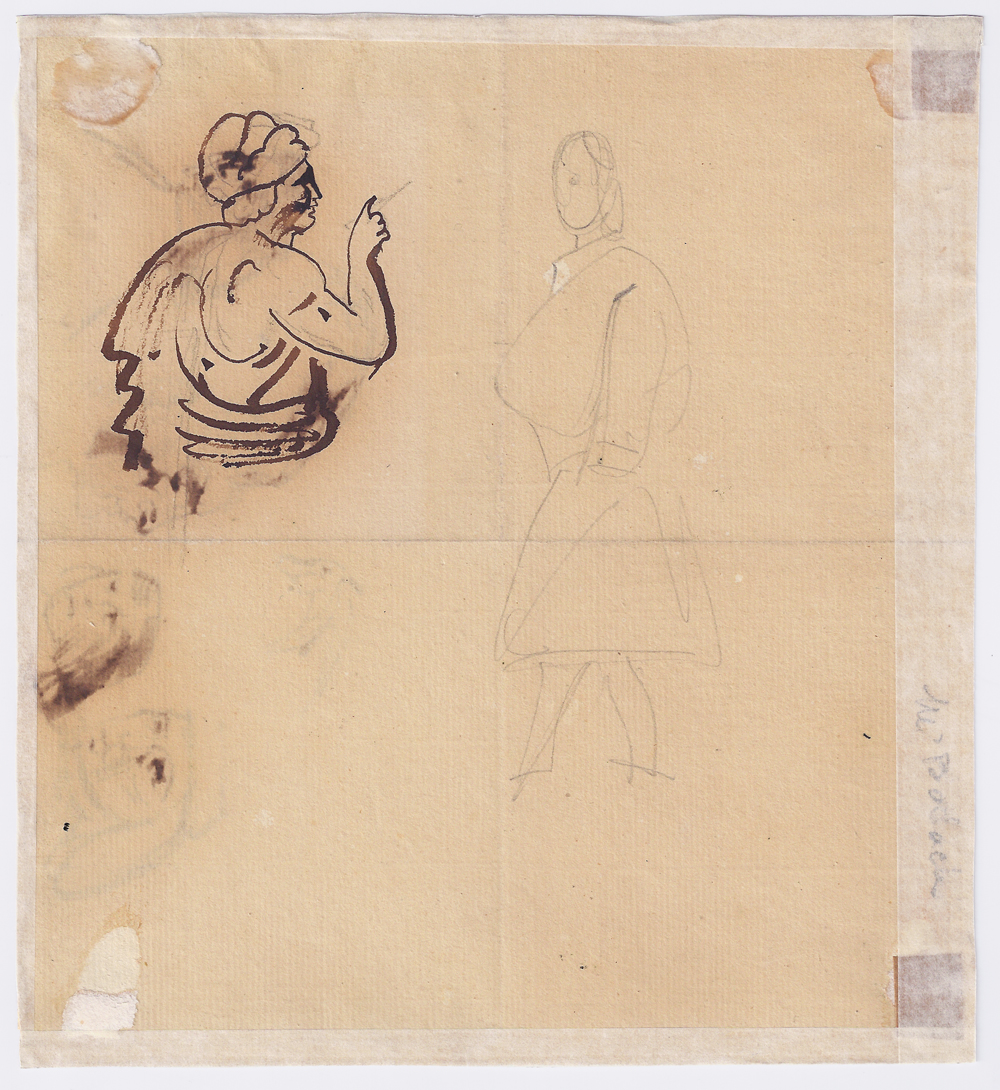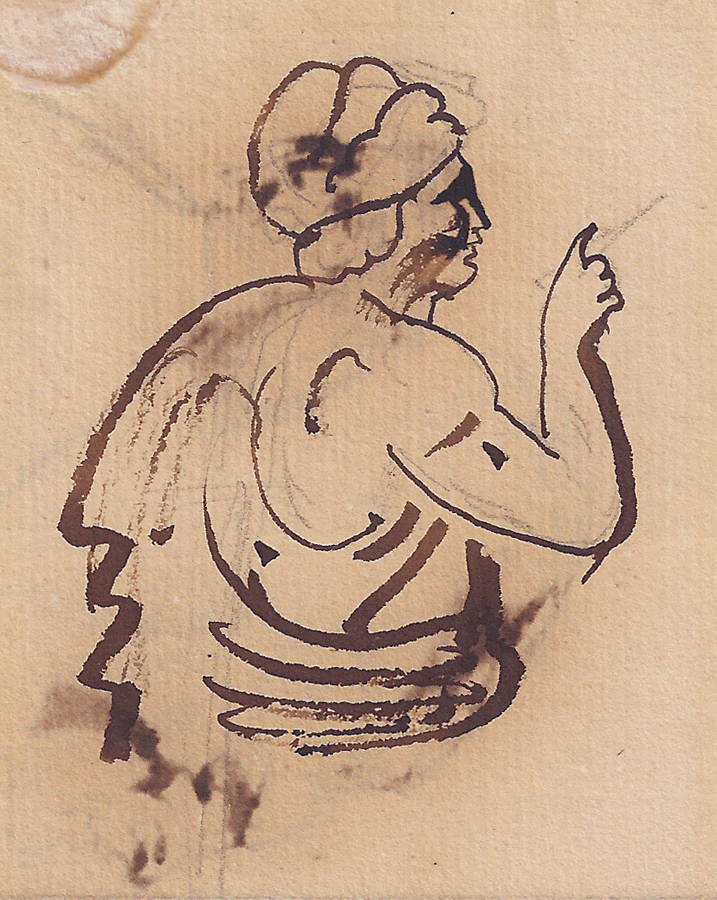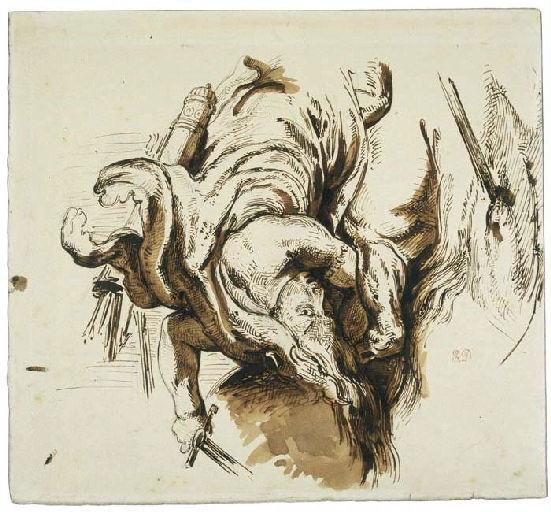FERDINAND-VICTOR-EUGÈNE DELACROIX (Charenton-Saint-Maurice 1798 – 1863 Paris)
Ferdinand-Victor-Eugène Delacroix (Charenton-Saint-Maurice 1798 – 1863 Paris)
Studies of Heads after the Old Masters (recto); Study of a Pointing Figure with Subsidiary Studies (verso)
Pencil, pen and brown ink, watermark VanderLey, 183 x 201 mm (7.2 x 7.9 inch)
Provenance
~ The artist’s studio stamp (Lugt 838a)
~ Possibly the artist’s studio sale, Hôtel Drouot, Paris, 17-29 February 1864, included in lot 630
~ William Bowmore OBE (1909–2008), Australia
***
Poet and art critic Charles Baudelaire described his hero Eugène Delacroix as ‘a volcanic crater artistically concealed beneath bouquets of flowers.’ Beneath the surface of Delacroix’s polished elegance and charm roiled turbulent interior emotions. In 1822 Delacroix took the Salon by storm.1 Although the French artistic establishment considered him a wild man and a rebel, the French government bought his paintings and commissioned murals throughout Paris. Though Delacroix aimed to balance Classicism and Romanticism, his art centered on a revolutionary idea born with the Romantics: that art should be created out of sincerity, that it should express the artist’s true feelings and convictions.
Educated firmly in the Classics, Delacroix often depicted mythological subjects, themes encouraged by the reigning Neoclassical artists at the Académie des Beaux-Arts. But Delacroix's brilliant colours and passionate brushwork frightened them; their watchwords were noble simplicity and calm grandeur. They barred him from academy membership until 1857, and even then he was prohibited from teaching in the École des Beaux-Arts. For those very reasons, he was an inspiration to the Impressionists and other young artists. Paul Cézanne once said, ‘we are all in Delacroix’. Intensely private, Delacroix kept a journal that is renowned as a profoundly moving record of the artistic experience.
Delacroix’s deep knowledge of earlier art is evidenced by his thorough study of the works of the Old Masters; his diaries record countless trips to the Louvre, and make repeated reference to his thoughts on the great painters of the past.2 He was particularly influenced by Rubens, for his 'exaggerations and his swelling forms' (Diaries, March 6, 1847) and by the Venetian artists of the 16th century for their profound sense of colour. Of Titian, Delacroix wrote: 'It is not, in my opinion, either by the depth of his expression or by a great understanding of the subject that he touches you, but by his simplicity and by the absence of affectation.' (Diaries, 4 October 1854).
Drawings by Delacroix after a great variety of artists are known, including Dürer, Giulio Romano, Titian and Veronese, Rubens and Van Dyck, Velazquez, Goya, Ingres, and the comical drawings by Thomas Rowlandson. As an example can be quoted his partial copy after Rubens’s Battle of the Amazons, preserved in the Musée des Beaux Arts, Dijon (see fig.).3 A pencil copy of St Catherine of Alexandria after an engraving of Titian’s altarpiece for the church of San Niccolò dei Frari, now in the Pinacoteca Vaticana, was sold at Christie’s in 2009.4 The heads on the recto of the present drawing appear to have been copied after Florentine 15th-century paintings. It is possible the drawing was included in lot 630 in the artist’s studio sale at Drouot in February 1864, which comprised a portfolio of drawings and sketches after the Old Masters.
The drawing was formerly owned by William Bowmore (1909–2008), one of Australia’s foremost collectors, whose collection included works by Rubens, Gainsborough, Degas, Modigiliani, twenty Rodin bronzes, and many other treasures.
Sold with an original certificate of authenticity signed by Madame Paule Caillac on 20 March 1980, attached to the reverse of the frame.
SOLD
1. For Delacroix as a draftsman, seef or instance: M. Sérullaz a.o., Dessins d’Eugène Delacroix 1798-1863, Paris 1984; and Lee Johnson, Eugène Delacroix (1798-1863): paintings, drawings and prints from North American collections, exh. cat. New York (Metropolitan Museum) 1991-92.
2. For Delacroix as a copyist, see for instance C. Leribault, Une passion pour Delacroix: la collection Karen B. Cohen, exh. cat. Paris (Louvre) 2009.
3. Pen and brown ink, 222 x 252 mm; inv. no. DG 421; S. Lemoine, Musée des Beaux-Arts de Dijon: Donation Granville: catalogue des peintures, dessins, estampes et sculptures, vol. I (Oeuvres réalisées avant 1900), Dijon 1976, no. 91, repr.
4. Pencil, 235 x 137 mm, Christie’s, New York, 29 January 2009, lot 75.
